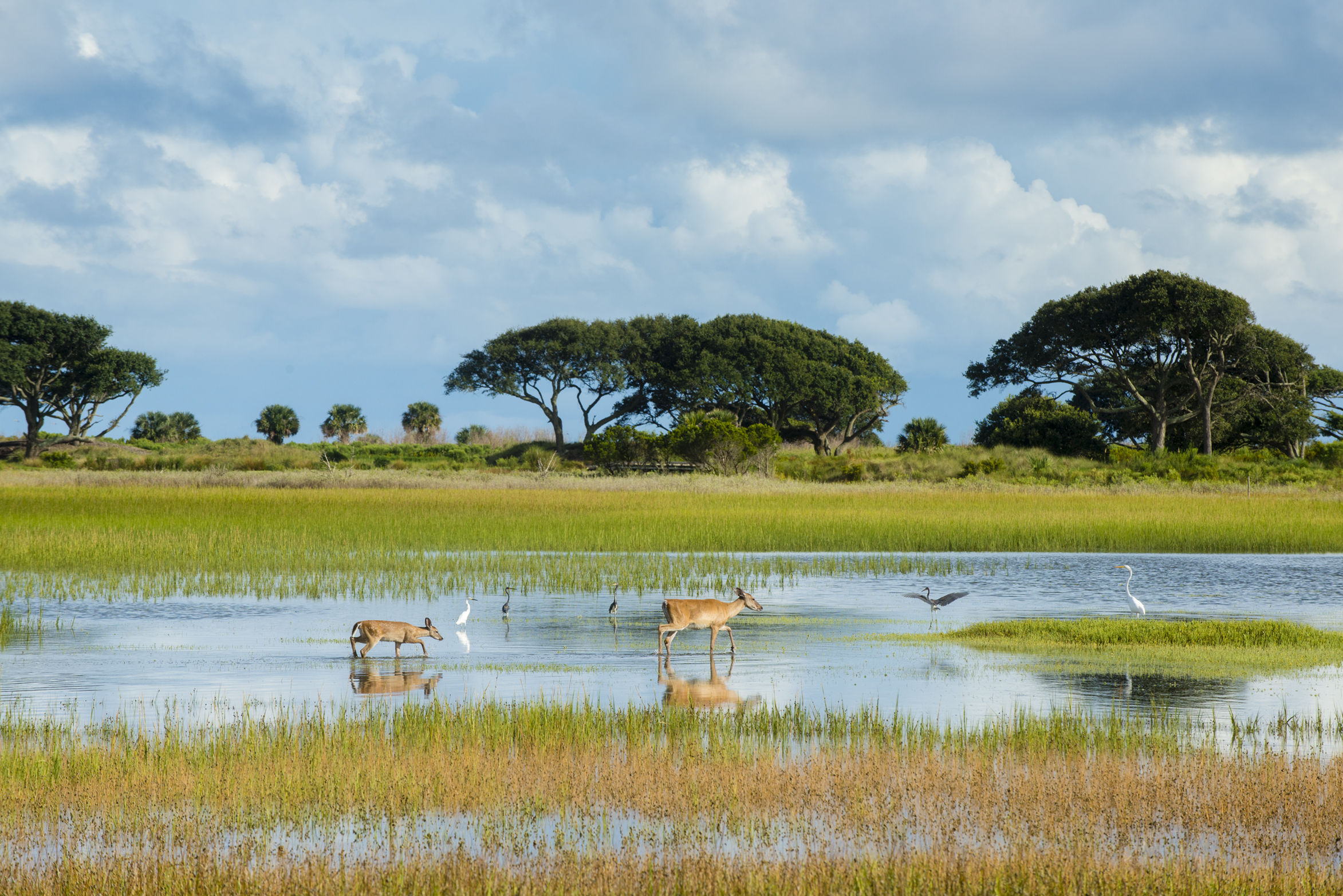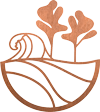Kiawah Island’s Abundant Animals
Kiawah Island boasts a unique balance of tasteful development and natural landscapes. There are plenty of ways to take a walk on the wild side on the island (by bike, on foot, or via kayak, to name a few)— and you’re likely to encounter some of Kiawah’s native animals during your stroll. Learn more about the birds, reptiles, and mammals that inhabit the island below based on their preferred terrain.
Beach
The island’s sandy stretch of beach along the Atlantic Ocean is as much a draw for native species as it is for Kiawah residents. Beach terrain and seawater offer a comfortable home for species like horseshoe crab, ghost crab, bottlenose dolphins, and loggerhead sea turtles.
Dogs aren’t allowed on the beach for an important, conservation-focused reason: birds. Native birds like black-bellied plovers, sanderlings, sandpipers, gulls, brown pelicans, and oystercatchers flourish in the east and west ends of the beach in particular.
Beach animals:
- Horseshoe crab: These alien-looking animals aren’t actually crabs at all! They’re a different type of marine arthropod and are so ancient (450 million years old!) that they’re considered living fossils.
- Ghost crab: These quick crustaceans love to run to and from sandy dunes to the water, looking at you all the way with elongated eye stalks. Their name comes from their translucent color and their increased activity at night!
- Bottlenose dolphins: These smart, beloved mammals typically travel in pods, or groups, of 10-30. You may notice their dorsal fins first as they surface for air while swimming.
- Loggerhead sea turtles: Loggerheads are an oceanic turtle that are an endangered species. They’re omnivorous (eat both vegetation and animal species) and nest on land, usually late at night in the summer months, roughly May through August.
- Black-bellied plovers: These long-distance migrants breed in the Arctic regions yet make their way all the way to Kiawah’s shores!
- Sanderlings: Similar to plovers, sanderlings typically breed in the high arctic tundra. When they’re in Kiawah, you’ll notice them wading in the water.
- Sandpipers: These cute shorebirds use their sensitive beaks to probe the sand for food.
- Gulls: These seabirds are closely related to terns, which you’ll also spot on the island. Gulls have a highly developed social structure and are intelligent animals known to use tools to help catch prey (they’ve even held bread in their beaks to catch fish!).
- Brown pelicans: Watch brown pelicans dive to catch their prey from above, holding fish in their large gullet. These large birds love to soar along the shoreline in tidy lines.
- Oystercatchers: Look for bright orange beaks and a black head to identify the oystercatcher, a medium-sized bird that wades in the shoreline.
Marshlands
Kiawah’s marshlands provide a rich habitat for birds like Carolina wrens, painted buntings, and several types of warblers. The salt marshes feature brackish water—a mix of fresh and saltwater—that attracts crabs like the stone crab (bonus: here are some tips to go crabbing!). Alligators also naturally live in marshland areas.
Marshland animals:
- Carolina wren: The Carolina wren is South Carolina’s state bird! This small bird has a shockingly loud, piercing call for its size. Keep your eyes peeled for its cinnamon-colored plumes and telltale white stripe above its eyebrow.
- Painted buntings: You’ll know a painted bunting when you see one. Its bright, primary colors are hard to miss! Look for a bright red belly, yellow feathers around its neck, and a deep blue head.
- Warblers: These small, colorful birds are named for their call, which sounds like a vibrato whistle. Listen up!
- Stone crab: The stone crab is widely caught for food — it’s a delicacy for humans and predators like grouper and sea turtles!
- Alligators: The American alligator is common throughout waterways on the island. Aggressive alligators are uncommon, but steer clear of these ancient animals, and report an aggressive one to our Town Hall, (843) 768-9166.
River
Rivers are a lifeline for animals living along the banks. On Kiawah, conservation areas like Beck Island benefit from the life-giving water of the Kiawah River. Beck Island offers prime habitat for birds, but it’s largely a refuge for mammalian wildlife like bobcats, deer, raccoons, and otters.
River animals:
- Bobcats: A type of lynx, bobcats are hunting cats with beautiful fur coats. They typically feast on smaller animals like squirrels or mice but have been known to hunt deer, particularly during the fawning season.
- Deer: Adaptable and adorable white-tailed deer live throughout Kiawah with a preference for river areas. Learn more about them here.
- Raccoons: These medium-size mammals are smart, social animals with a telltale black mask fur pattern.
- Otters: Otters were recently spotted on Beck Island! These semiaquatic mammals are playful, natural-born swimmers.
Woods
Kiawah Island is home to a maritime forest — shoreline estuaries with trees in reach of salt spray. The maritime forest is home to many of the same animals you’d find in river areas like Beck Island as well as some of the animals who call the marshlands home. This includes deer, raccoons, and painted buntings.
Guided Nature Walks
Now that you know more about Kiawah’s many animals, you may be interested in one of our guided naturalist walks. We offer a variety of guided tours, including a nighttime beach walk, ocean beachcombing and seining, a sunset cycle, a wetlands bike ride, and beginning birding classes all designed to nurture a love of nature. Browse them all here.
Nature-Adjacent Properties
When you become a Kiawah Island homeowner, you receive unparalleled access to the island’s pristine, natural habitats. However, if you’re an adamant nature lover, some properties offer more access to flora and fauna than others. Be the first to live at 456 Caroline Shores Lane, a forthcoming property in the Ocean Park neighborhood nestled in Kiawah’s marshlands and designed by award-winning architect Christopher Rose. Or, enjoy peaceful woodland views at 509 Claret Way in the Cassique neighborhood. Its open-concept floor plan means you’ll have a clear view of nature from any spot in the house.






